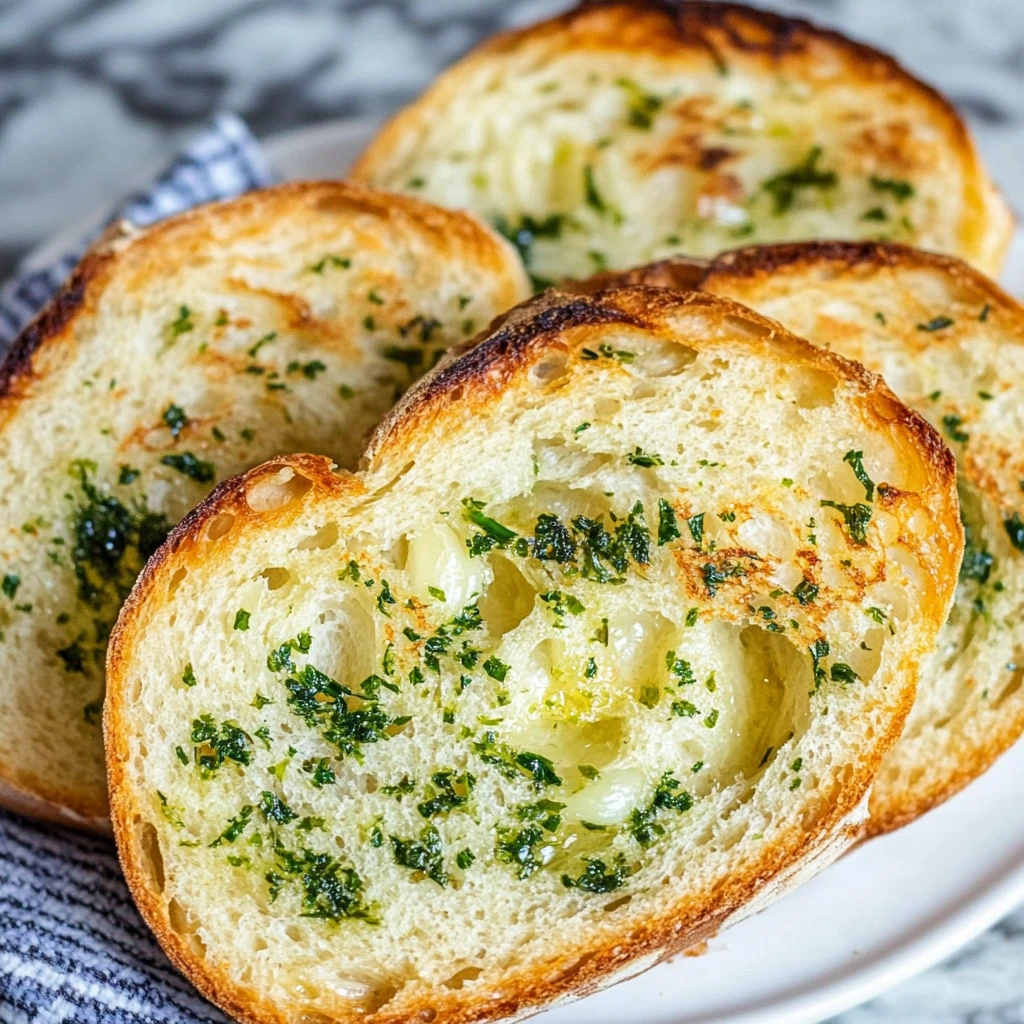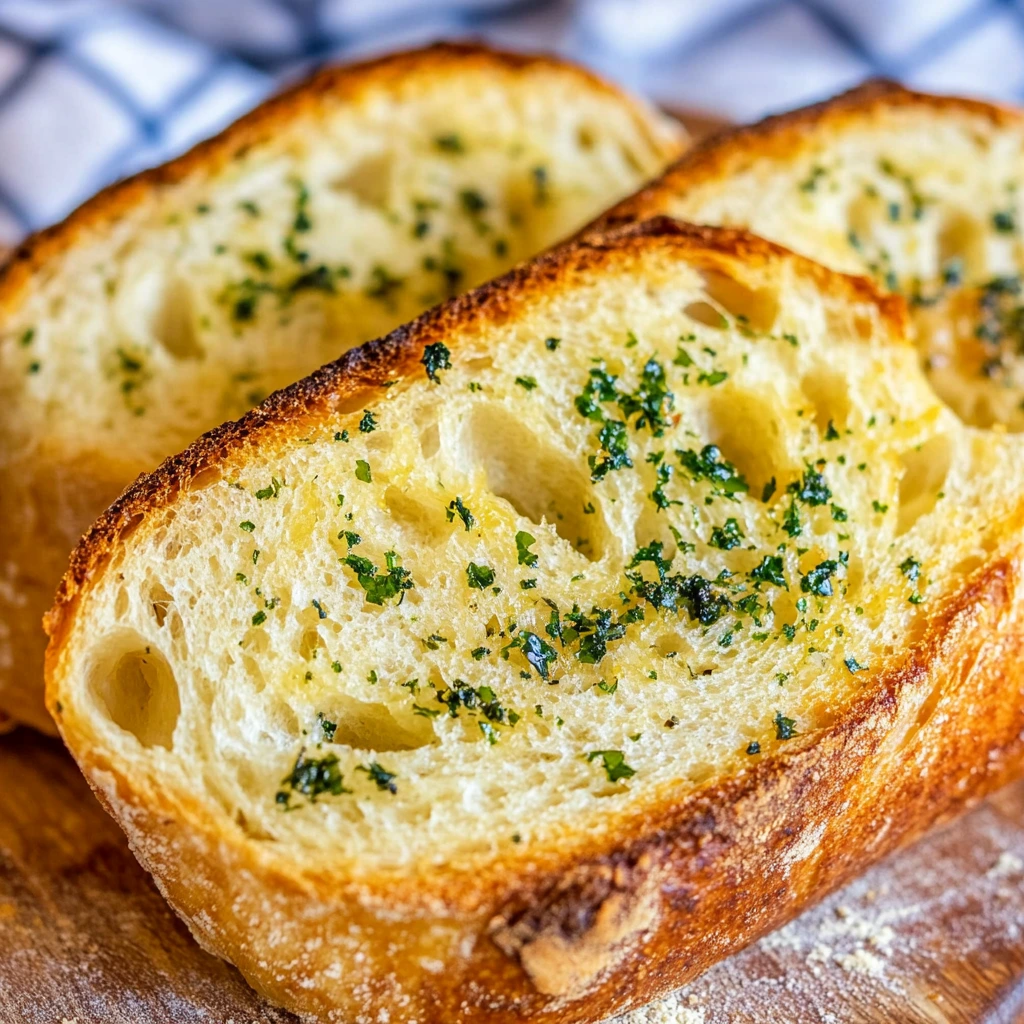Sourdough Garlic Bread: A Delightful Fusion of Flavors

Sourdough garlic bread combines the tangy, rich flavors of traditional sourdough with the savory, aromatic essence of garlic. This fusion is not just a treat for the taste buds but also a versatile addition to any meal. Whether you’re hosting a dinner party or enjoying a quiet meal at home, sourdough garlic bread can elevate the dining experience. Let’s delve deeper into its rich history, explore the techniques for making it at home, and discover the secrets to perfecting this culinary masterpiece.
Introduction to Sourdough Garlic Bread
The History of Sourdough Bread
Sourdough bread has been cherished for centuries, with roots tracing back to ancient Egypt around 1500 BCE. Furthermore, unlike commercial breads made with quick-rise yeast, sourdough relies on natural fermentation. Consequently, this process creates its characteristic tangy flavor and chewy texture, making it a staple in various cuisines worldwide.
What sets sourdough apart is its unique starter—a mixture of flour and water fermented by wild yeast and lactic acid bacteria. Over time, this method has become a symbol of artisanal baking, emphasizing quality over convenience.
Why Garlic Complements Sourdough
Garlic’s pungent and slightly sweet flavor beautifully complements sourdough’s tangy notes. When roasted, garlic becomes caramelized, bringing out a mellow sweetness that contrasts and harmonizes with sourdough’s tartness. Moreover, garlic’s health benefits, including immune-boosting and heart-protective properties, make it a delightful and nutritious addition.
Ingredients Needed for Sourdough Garlic Bread
Essential Sourdough Starter Basics
A sourdough starter is the heart of any sourdough recipe. To create your starter, combine equal parts of flour and water, leaving it to ferment for 5–7 days while feeding it daily. This process cultivates the wild yeast needed for leavening.
Maintaining a starter is straightforward: keep it in a cool, dry place and feed it regularly with fresh flour and water. This practice ensures the starter remains active and flavorful for your bread.
Key Ingredients for Garlic Bread
In addition to a healthy sourdough starter, you’ll need these essentials:
- Flour: Bread flour is ideal for its high protein content, ensuring a chewy texture.
- Garlic: Use fresh garlic for the best flavor. Roasted garlic adds a sweeter, mellower note, while minced raw garlic provides a sharper bite.
- Butter or Olive Oil: These fats enrich the bread and help carry the garlic’s flavor.
- Herbs: Parsley, rosemary, or thyme can enhance the bread’s aroma and taste.
- Cheese (Optional): Parmesan or mozzarella can create a decadent, cheesy crust.
Preparing the Dough
Crafting the Perfect Sourdough Dough
Making sourdough dough requires patience and precision. Here’s a step-by-step guide:
- Mixing: Combine your sourdough starter, flour, water, and salt in a large bowl. Mix until a shaggy dough forms.
- Autolyse: Let the dough rest for 30 minutes. This step helps hydrate the flour, making it easier to knead.
- Kneading: Knead the dough gently to develop gluten.
- Bulk Fermentation: Allow the dough to rise for several hours, folding it every 30 minutes to build strength.
Infusing Garlic Flavor
To incorporate garlic, consider these techniques:
- Roasting: Roast garlic bulbs until golden and soft, then mash into a paste.
- Mincing: Finely chop raw garlic for a bold, punchy flavor.
- Mixing: Add the garlic directly into the dough during kneading or folding.
For an even flavor distribution, ensure the garlic is thoroughly mixed.
Shaping Techniques for Sourdough Bread
Shaping sourdough is an art. Whether you prefer a rustic boule or a sleek baguette, the shape affects both presentation and baking. To shape:
- Gently flatten the dough into a rectangle.
- Fold the edges inward, creating tension on the surface.
- Place the dough seam-side down into a proofing basket.
Proofing for Maximum Flavor
Proofing allows the dough to develop its complex flavors and structure. For sourdough garlic bread, proofing can take 4–6 hours at room temperature or overnight in the refrigerator. Use a finger dent test to check readiness—a slight indentation should spring back slowly.
Don’t miss our Chicken Dressing Casserole – it’s packed with flavor and perfect for family dinners!
Baking the Perfect Sourdough Garlic Bread
Temperature and Timing
Baking sourdough requires high heat—typically 475°F (245°C)—to create a crisp crust and airy crumb. Preheat your oven with a baking stone or Dutch oven for consistent results. Bake for 20 minutes with steam, then remove the cover to finish.
Achieving a Golden Garlic Crust
For an irresistible crust:
- Brush the dough with garlic-infused butter before baking.
- Sprinkle herbs and grated Parmesan for a golden, flavorful finish.
This step not only enhances flavor but also adds visual appeal.
Storing and Serving Suggestions
Best Practices for Storing Sourdough
Sourdough garlic bread stays fresh for 2–3 days at room temperature. Wrap it in a clean towel or store it in a paper bag to maintain its crusty texture. For longer storage, freeze slices and reheat as needed.
Serving Ideas and Pairings
Sourdough garlic bread pairs wonderfully with soups, salads, and pasta. For a creative twist, use it as a base for bruschetta or croutons in Caesar salads. The possibilities are endless!
Health Benefits of Sourdough Garlic Bread
Nutritional Value of Sourdough
Sourdough fermentation enhances digestibility and nutrient absorption. It’s also lower in glycemic index compared to other breads, making it a healthier choice.
Garlic’s Health Properties
Garlic is a powerhouse of nutrients, offering antioxidants and compounds that support heart health and immunity. Combined with sourdough, it creates a bread that’s as nutritious as it is delicious.
Troubleshooting Common Issues
Overproofing or Underproofing
Overproofed dough may collapse, while underproofed dough lacks volume. Monitor proofing carefully and adjust based on your kitchen’s temperature and humidity.
Achieving Balanced Garlic Flavor
Avoid overpowering the bread by using the right amount of garlic. Balance it with herbs and butter to ensure a harmonious flavor profile.
FAQs
What not to do with sourdough?
When working with sourdough, it’s important to keep a few things in mind to avoid common pitfalls. For starters, don’t use metal bowls or utensils, as they can react with the acidic dough and alter its flavor or texture. Additionally, don’t rush the fermentation process—sourdough needs time to fully develop its tangy taste and structure. Moreover, avoid overfeeding your starter or using it when it’s inactive, as this could prevent your dough from rising properly. Lastly, steer clear of storing sourdough in non-airtight plastic containers, as this can encourage unwanted bacteria or mold to grow.
Why is sourdough bread not fattening?
Sourdough bread is often seen as a healthier option because of its unique fermentation process. For one thing, the fermentation breaks down gluten and starches, making it easier to digest and less likely to cause bloating. Furthermore, sourdough has a lower glycemic index than regular bread, meaning it causes fewer spikes in blood sugar, which is key for maintaining energy and satiety. Although it still contains calories, it’s rich in nutrients and fiber, which helps you feel fuller longer. In short, it’s a wholesome choice for those looking to manage their diet without feeling deprived.
What is the best combination for garlic bread?
When it comes to garlic bread, the best combinations bring together bold flavors and a perfect texture. First of all, mix softened butter with freshly minced garlic, a sprinkle of parsley, and a dash of Parmesan or mozzarella cheese for richness. Then, spread this mixture generously on a crusty bread like a baguette or sourdough. Additionally, for a spicy twist, you can add a pinch of chili flakes, or for a deeper flavor, drizzle a little olive oil. Serve it warm alongside pasta, soups, or salads, and you’ll have a side dish that’s hard to resist.
Can you use sourdough instead of yeast?
Absolutely, sourdough can be used in place of commercial yeast, but there are a few things to keep in mind. Since sourdough works more slowly, you’ll need to allow extra time for the dough to rise—often several hours or even overnight. What’s more, sourdough not only acts as a leavening agent but also adds a distinct tangy flavor and chewy texture to baked goods. Just make sure your starter is active and bubbly before using it, as this ensures the dough will rise properly. All in all, it’s a fantastic natural alternative to yeast.

